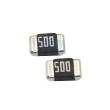Analysis of Core Parameters and Safety Requirements for Alloy Resistors
1、 Basic electrical parameters
Nominal Resistance Value
Range coverage: 1m Ω 1 Ω, accuracy up to ± 1%
Using vacuum sputtering technology to achieve precise resistance control
Power Rating
Standard specification: 0.25W5W
The power derating curve needs to match the ambient temperature (55 ℃~+170 ℃)
Temperature coefficient (TCR)
Typical value: ± 50ppm/℃
Copper nickel alloy can achieve ultra-low drift of ± 20ppm/℃
Rated Voltage
Calculation formula: √ (P × R), must meet the IEC60115 standard

2、 Structural characteristic parameters
Package Size
Surface mount: 0402/0603/2512, etc
Plug in: TO220/TO247 package
Terminal structure
Copper tin/silver electrode, compatible with reflow soldering process
Four terminal structure reduces contact resistance (Kelvin connection)
3、 Key safety parameters (6% of fuse safety keywords)
Fusing characteristic
Complies with UL248/IEC60127 standards
Anti surge current capability: 100A/1ms (in compliance with safety fuse testing requirements)
Flame retardant grade
The substrate has passed UL94 V0 certification
Ceramic substrate temperature resistance>800 ℃ (meets the requirements of fuse melting and fire prevention)
insulation voltage
Package withstand voltage>500VAC (compliant with IEC60664 safety spacing)
Environmental friendliness of materials
Compliant with RoHS2.0/REACH
Free from harmful substances such as cadmium and lead
4、 Certification standards
Compulsory certification: CQC/UL/CURus
Vehicle specification level: AECQ200 Grade 1
Medical safety regulations: ISO13485 (compatible with medical fuse standards)
Application suggestion: In scenarios such as new energy BMS systems, it is necessary to simultaneously refer to the alloy resistance parameters and fuse safety requirements to ensure that the overcurrent protection function and resistance stability meet the dual standards. When selecting, the focus should be on verifying the surge resistance test data in the TUV certification report and matching it with the IEC62368 safety specification.
